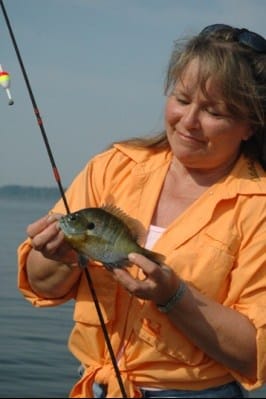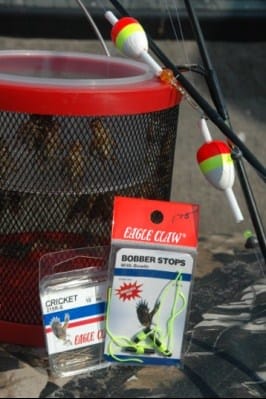
I don’t care how old you are, or how long you’ve been fishing. There’s just something about watching that little bobber disappear under the surface – pencil bobber, red/white round bobber, high-tech quill bobber, Snoopy bobber…doesn’t matter – that just does something to a body. One minute she’s there; next, she’s gone. Or she’s skimming across the top headed, it seems, for the other side of the pond. It gets your heart racing, it does – or at least it should.
And there are few species as adept at tugging a bobber away from the surface as is the bluegill. Found coast to coast across the United States, bluegills are – and I think I’m safe in saying this – responsible for the start of more lifelong fishing careers than are Misters Zebco, Mitchell, and Pflueger combined. And, I should add, with good reason. Along with their ubiquitous distribution, ‘gills are willing biters throughout the whole of the year, eagerly devouring any number of live and artificial selections thrown their way. Once hooked, they give a dandy tussle, especially on light, or better yet, ultralight tackle. And speaking of tackle, ‘gill gear can be as simple or as complex as an angler wishes. Cane poles strung with eight feet of Old School braided nylon line and finished with a Aberdeen style No. 6 snelled hook – And let’s not forget that bobber! – tipped with a hand-dug garden worm work incredibly well. So, too, can high-dollar graphite rods outfitted with the latest in reel technology, and rigged with 1/64-ounce jig so realistic, you’d think it was – well – real. And tablefare? To me, only cool water crappies can compare to a paper plate heaped with lightly breaded fresh-from-the-fryer bluegill fillets. Yeah, they’re that good.
Across much of the northern United States, March is a fickle time of year for fishermen. The safe ice of the past three months is, in many cases, no longer trustworthy, and the open water, what there is of it, is often so cold that it might as well be ice-choked. That’s not to say fish can’t be caught – they can – but rather that angling in, say, northern Iowa during mid-March can be a frustrating proposition. That said, and if it’s early Spring ‘gills I seek, I’ll head south of the Mason-Dixon Line to waters in Alabama, Mississippi, Arkansas, Florida, Georgia and the like. Here, year-round warm water allows bluegills to grow big. And grow they do, with one-pound bulls not being uncommon. Personally, though, and if cornered to make the dreaded one place ‘n one place only type of decision, mine – fortunately – would be relatively easy – Reelfoot Lake.
Located in the northwest corner of Tennessee, this shallow – 5-1/2 foot average depth; 18-foot maximum – 18,000-acre natural lake was formed by a series of violent earthquakes during the early part of the 1800s; quakes so strong that the Mississippi River literally ran backwards, and in doing so, filled an immense sinkhole with river water, thus creating Reelfoot Lake. Known perhaps moreso for her premier crappie fishery, Reelfoot supports an incredible population of big-as-your-hand bluegills and, unbeknownst to many, one of the country’s finish still-water channel catfisheries. March typically heralds the kick-off of the bluegill season, so to speak, on Reelfoot; however, the fishery gets nothing but better as Spring gives way to Summer.
Bait ‘n Tackle

Baits and tackle employed on Reelfoot can, and quite successfully, be used elsewhere across the country, and, as mentioned earlier, can be either as simple or as complex as one wishes. Live bait enthusiasts will, I believe, agree few offerings can match the effectiveness of crickets when it comes to targeting big ‘gills. Lightly hooked underneath the collar – a ring of tough exoskeletal material located just behind the insect’s head – on a #6 long shank bait-specific hook, crickets are traditionally fished below a small bobber around cover, e.g. stumps, standing dead timber, or emergent vegetation. Small (2- to 3-inch) redworms or garden worms can also work well, nationwide; so, too, can larval baits such as waxworms or mealworms.
Artificial presentations can be extremely effective for ‘gills, particularly on larger fish. The key to using artificial baits for bluegills is to remember one simple word – small. And slow, where slow refers in most cases to the speed at which one works the lure, be it jig, fly, spinner, or down-sized crankbait. Among the artificials, tiny jigs – 1/32- or 1/64-ounce – are perhaps the most popular, with one of my favorites being an elemental leadhead festooned with silver mylar (tinsel), and wrapped lightly with red thread. Called the Mighty Mite, this minnow imitation works well not only on ‘gills, but for crappies, yellow perch, trout, white bass, and the occasional channel ‘cat. Good choices in artificials for ‘gills also include tube and/or marabou jigs, inline spinners, e.g. Mepps or Panther Martins, and diminutive crankbaits like the Rat-L-Trap Tiny Trap, or the Mini Fat Rap by Rapala.
And let’s not forget the fly-fishermen, who can, when armed with a good 4- or 5-weight fly rod, a selection of No. 2 tippets, and a flip-top box filled with poppers, hopper imitations, two-inch streamers, ants, spiders and bees.
Overshadowed, perhaps, by freshwater superstars like walleyes and largemouth, bluegills are more than capable of holding their own, both at the end of the line as well as on the table. And let’s be honest here, eh? There’s still that excited feeling that comes over us when we watch bobber disappear, now isn’t there?
The Union Sportsmen’s Alliance website is designed to provide valuable articles about hunting, fishing and conservation for members of AFL-CIO affiliated labor unions and all sportsmen and sportswomen who appreciate hunting and fishing and want to preserve our outdoor heritage for future generations. If you would like your own story and experience from the outdoors to be considered for our website, please email us at[email protected].







